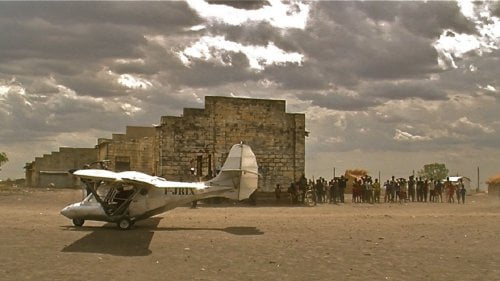We Come as Friends

South Sudan claimed its independence to escape the brutality of North Sudan’s cruel president, Omar al-Bashir. The events are visited by documentarian Hubert Sauper in his homemade airplane, constructed of metal tubes, canvas and wires, and he comes to a country trapped in its past and uncertain of its future. He chronicles what the future may hold for the war-torn land in “We Come as Friends.”
Laura's Review: A-
Hubert Sauper ("Darwin's Nightmare") flies from France to Sudan just as South Sudan is voting for its independence. He travels in a home made plane, one he describes as a tin can with fabric wings run with a motorcycle engine. It's a disarming device, astonishing all who see it, allowing him to talk to everyone from UN officials to warlords, locals living just like their ancient ancestors and the foreign investors who insist "We Come as Friends." This beautifully shot documentary is an in depth examination of Sudan from myriad points of view. Sauper gets a brief history of Africa from a local 'They come and factionalize it all up. They sent a gun to shoot an elephant for a white man. That's how it all started.' He listens to others, impassioned, describe how Sudan is more democratized than the United States, how they can do their own building, keep their own peace. But what Sauper has chronicled is their doom. Within Sudan we have Muslim war criminal Omar al-Bashir in the north, the Christian President Salva Kiir wearing his black cowboy hat from George W. Bush in the South. Sauper crosses paths with George Clooney, but also with Texan missionaries whose biggest concern is the natives' nakedness and who beat children who do not wear their school uniforms. The Chinese, who are harvesting over 300,000 barrels of oil a day in the South, compare American space exploration to the European colonialism in Africa. On TV, Hillary Clinton rejects a new colonialism in Africa while a Dallas based company leases 600,000 hectares for $25,000 to exploit all its natural resources. It's a 'win win' for everyone we repeatedly hear as locals are forced from their homes to live in ecological disasters that it is 'their responsibility to clean up.' It's heartbreaking. And yet Sauper's made a beautiful film, his aerial photography breathtaking and alien, often accompanied by standards from British jazz singer Malia. As 'the newest country in the world' goes to civil war, Sauper incorporates footage shot on the battlefield by a South Sudanese soldier. Like the ending of an old fable, the last words we hear are 'Did you know the moon belongs to a white man?' Grade:
Robin's Review: B+
That Herbert Sauper would come to such a tumultuous land to document its independence is a feat unto itself. That he makes this journey from France in his self-made plane powered by a motorcycle engine ramps up the feat by a magnitude. This is a bit of a problem for the film as his personal accomplishment sometimes overshadows the real subject – the conflicts that South Sudan, the newest nation in the world, now faces. The center of the troubles in the new country should be its blessing – 300000 barrels of oil produced per day. This black gold should be South Sudan’s salvation. Instead, forces led by al-Bashir attack to take the fields by force. It gets worse, though, as China forces its influence on the underdeveloped nation to tap the valuable resource for itself. Other nations, through the promise of economic development, are performing their own brand of neo-colonialism. Like the Native Americans, the Sudanese consider the land resource for all, which is resulting in much the same circumstance – the South Sudanese are losing their nation to multinational influences that are in the country to “help” the people. Sounds like the Old West, doesn’t it? “We Come as Friends” is a personal triumph for Herbert Sauper in his making what must have been an often frightening journey. Think of flying thousands of miles in a homemade machine not that different from airplanes of 100 years ago. This could have been a documentary on its own. But, the filmmaker uses his little plane to give us a bird’s eye view of a country struggling with keeping its independence against the odds.

